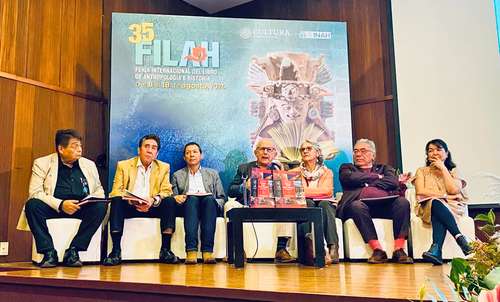The INAH centers represent a fundamental part of the brain of the National Institute of Anthropology (INAH), said its director, Diego Prieto Hernández, at the presentation of the book INAH Centers: Approaches from within. 85 years of INAH, work that reflects the tireless efforts of the organization to protect and disseminate the vast cultural legacy of the nation.
The central event, part of the closing ceremony of the International Book Fair of Anthropology and History (FILAH), took place yesterday in the Fray Bernardino de Sahagún auditorium of the National Museum of Anthropology, where committed and passionate voices spoke out to protect and disseminate Mexico’s heritage.
The ceremony was attended by key figures of the institution, such as the heads of the INAH centers, Víctor Hugo Valencia Valera (Morelos), Rosa Estela Reyes García (Querétaro), José Vicente de la Rosa (Tlaxcala) and René Alvarado López, coordinator of the centers, who offered their perspectives on the functions and challenges they face in their regions.
Prieto Hernández shared his experience when he was in charge of the INAH Querétaro Center, which he discovered to be the most rewarding and instructive stage of his career.
“The most fruitful task from a professional point of view, and where I have learned the most, has been directing the INAH Querétaro Center. For me, any part of the country is as important as Mexico as a whole.
The creation of the regional centers was promoted by Guillermo Bonfil Batalla, when the institute turned 50 years old, between 1972 and 1976. These centers represented the first commitment of the INAH to develop suitable policies.
However, the director of INAH spoke of the challenges that these centers have faced over the years, mentioning that The conflicts of the INAH in the states are due to how corrupt the state authorities are.
According to him, many of the institutes that resisted state pressure stopped receiving support or were forced to bow to other interests, prioritizing an ornamental and touristic vision over actions of true academic substance.
“In 1984, under the direction of Enrique Florescano, the INAH Querétaro Center was founded, which marked a milestone in the implementation of appropriate cultural policies for that entity. The complete formation of the INAH centers in each state was not achieved until 1995, with Sinaloa, Coahuila and Tamaulipas being the last to establish their centers, although they were small in size.
The work of these centers, as reflected in the book, is essential to keeping the mission of the INAH alive and ensuring that cultural policies have a real and significant impact in each region of Mexico.
His conviction about the relevance of the INAH centers was clear: I am convinced that our task has to do with building a cultural project that translates the general and intellectual program of the institute to the regional, historical, ethnic, linguistic and community singularities of each entity.
This requires in-depth research and study, as well as strong administrative capacity.
“INAH centers are the foundations of the institute. They are what give us territoriality. These institutions are also the operational arms that generate the capacities for substantive action in each place.
They are not only operational, but also intellectual. They represent the eastern hemisphere of the brain, because in the other hemisphere are the substantive areas in the field of building policy, lines of action and work of national coordination. In the institute’s centers we have brains that investigate, study and document.
The INAH is present in all states of the Mexican Republic through its regional centers, which handle rescues, complaints and procedures for the care of monuments and archaeological and historical zones, as well as assets of paleontological interest; they also promote anthropological and historical research.
From August 8th to 18th, More than 145 thousand visitors met at FILAH
and participated in the 400 scheduled activities. The enthusiasm and relevance of the meeting managed to extend its reach beyond the walls of the National Museum of Anthropology, as another 175 thousand people connected remotely to follow the online broadcasts, according to the organizers.
